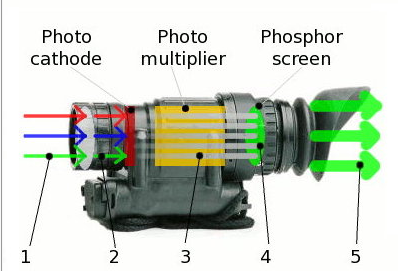2019-11-28
Tel : 0086-29-89589035
Web : www.mh-elec.com
Please click or email to
mh_elec@126.com or jacky@mh-elec.com
1. How do night vision goggles work?

1) Dim light from a night scene enters the lens at the front. The light is made of photons (particles of light) of all colors.
2) As the photons enter the goggles, they strike a light-sensitive surface called a photocathode. It's a bit like a very precise solar panel: it's job is to convert photons into electrons (the tiny, subatomic particles that carry electricity round a circuit).
3) The electrons are amplified by a photomultiplier, a kind of photoelectric cell. Each electron entering the photomultiplier results in many more electrons leaving it.
4) The electrons leaving the photomultiplier hit a phosphor screen, similar to the screen in an old-fashioned television. As the electrons hit the phosphor, they create tiny flashes of light.
5) Since there are many more photons than originally entered the goggles, the screen makes a much brighter version of the original scene.
2. Why does everything look green through night vision goggles?
Even at night, the photons that hit the lens at the front of night vision goggles are carrying light of all colors. But when they are converted to electrons, there's no way to preserve that information. Effectively, the incoming, colored light is turned into black and white. Why, then, don't night vision goggles look black and white? The phosphors on their screens are deliberately chosen to make green pictures because our eyes are more sensitive to green light. It's also easier to look at green screens for long periods than to look at black and white ones (that's why early computer screens tended to be green). Hence, night vision goggles have their characteristic, eerie green glow.
3. What if there really is no light?
Night vision goggles like the ones described above are sometimes called image intensifiers, because they take the tiny amount of light that's available in near darkness and boost it enough for our eyes to see. But sometimes there just isn't enough light to do this—and image intensifier goggles simply don't work. Suppose, for example, you're a firefighter trying to see if there's anyone trapped inside a smoke-filled building, An image intensifier would be as useless as your own eyes.
The alternative is to use what's called thermal imaging. Instead of looking for the light that objects reflect, we look for the heat they give off instead. Generally, living things moving around in the darkness are going to be hotter than their surroundings; that goes for vehicles and machines too. Hot objects give off infrared radiation, which is a similar kind of energy to light but with a slightly longer wavelength (lower frequency). It's relatively easy to make a camera that picks up infrared radiation and converts it into visible light: it works like a digital camera except that the image detector chip (either a charge-coupled device (CCD) or a CMOS image sensor) responds to infrared instead of visible light; it still produces a visible image on a screen the same way as an ordinary digital camera. Other types of thermal imaging cameras use different colors to indicate objects of different temperature—and they're commonly used to show things like the heat loss from badly insulated buildings.
 tel
tel
